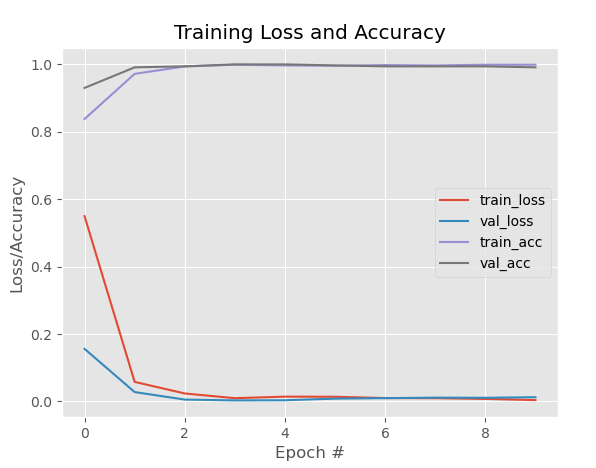Implementing a face mask detector using Keras and OpenCV.
- python3
- keras V2.4.3
- tensorflow V2.3.0
- numpy V1.18.5
- scikit-image V0.17.2
- opencv-python V4.3.0.36
- matplotlib V3.2.2
- imutils V0.5.3
- Train a transfer learning neural network to detect face masks.
- Detect face region of interests (ROIs) from an input image using pre-trained Haar Cascades classifier.
- Run a prediction on these and evaluate and fine-tune hyperparmeters of the network.
- A Dataset
- A loss function
- A neural network architecture
- An optimization method
Reference to Prajna Bhandary's Dataset:
1,376 images belonging to two classes:
- with_mask: 690 images
- without_mask: 686 images
- batch_size: 32 images
- train_test_split: 75%-25%
Applying data augmentation to increase the generalizability of the model while obtaining additional traditional data.
Fine-tuning Inception V3 network structure from keras applications:
The goal of the inception module is to act as multi-level feature extractor by computing 1x1, 3x3, and 5x5 convolutions within the same module of the network.
This process enables the network to learn both local features via smaller convolutions and abstracted features with larger convolutions.
Main model architecture:
- Replace the head of a network with a new, randomly initialized head.
- The layers in the body of the original network are frozen.
- Train the new FC layers until a reasonable accuracy. (for 25 epochs)
- Unfreeze the previous layers and train the entire model again. (for 10 epochs)
- SGD (Stochastic Gradient Descent)
- Adam (Adaptive Moment Estimation)
Training Process Log: Evaluated to 99% Accuracy Average
| class | precision | recall | f1-score | support |
|---|---|---|---|---|
| with_mask | 0.98 | 1.00 | 0.99 | 172 |
| without_mask | 1.00 | 0.98 | 0.99 | 172 |
- Inception V3 network might have been an over qualified arhictecture to fine-tune for this problem and dataset. Therefore, smaller epochs are used in my training to achieve satisfactory results.
- Prevent overfitting your model through regularizations techniques such as data augmentation and dropout layers.
- Always apply a momentum and a decay to your learning rate making your updates to your loss function adaptive which in turn increases generalization and classification accuracy.
- Fine-tuning and feature extraction works best with different kinds of problems. Therefore, try experimenting with both and become familiar with the transfer learning process.
- If working with a larger dataset, store the data to a binary format such as HDF5 beforehand to prevent I/O bottlenecks.
- The more practice you have at training neural networks, monitoring the results and tuning the hyperparameters, the better you'll become at it.
- Evaluation results have shown that, my trained model works nicely with a single person images, but it has problems with an image with multiple people. My guess is that Haar Cascades parameters need to be tuned more carefully to properly detect faces initially before applying mask detection.
- Also, train using your GPU to save time on your multiple trail of trainings. With models that has deeper amount of layers, CPU bottlenecks could cost you several hours of training during the back-propagation process.
- Finally, it was a fun and a challenging project. I learned a lot and wear your masks :).
